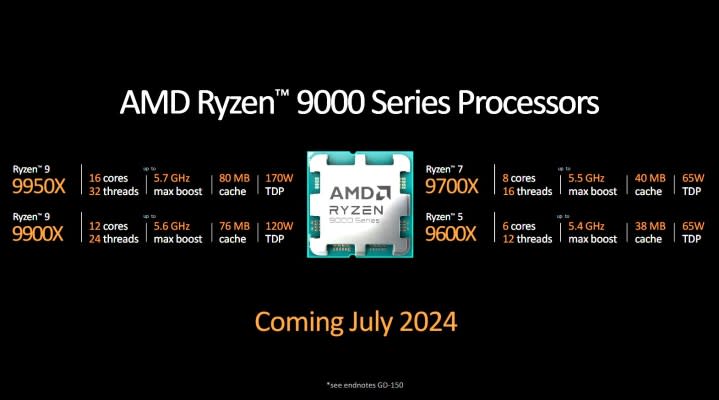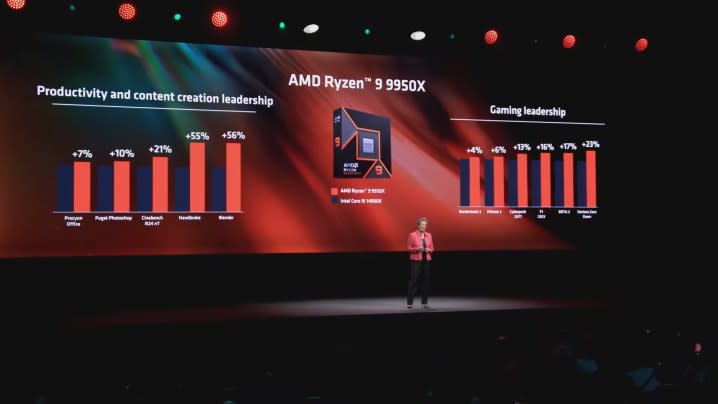AMD just answered the question everyone’s been asking about Ryzen 9000

It’s not surprising that AMD released its Ryzen 9000 CPUs at Computex 2024. The company confirmed its Zen 5 chips would arrive this year, and Computex is the perfect place to release them. AMD answered two big questions about Ryzen 9000 in Taipei, however: When does Ryzen 9000 come out, and how long will AM5 last?
Let’s start with that last question. AMD committed to supporting the AM5 platform through 2025 originally, but with the launch of Ryzen 9000, it’s recommitting. The company says it will support AM5 through at least 2027, and likely beyond that point. Everything works together, too. New Ryzen 9000 parts will work with older 600-series chipsets, while older Ryzen 7000 CPUs will work with the new 800-series chipset (more on that shortly).

We also have a release window, and it’s much sooner than expected. AMD is releasing four Ryzen 9000 processors in July, just a month away from now. We don’t know the exact date or pricing yet, but we won’t have to wait long.
So, those are two big questions answered, but there are still some details to dig into in the specs. AMD is releasing four CPUs, and you’ll probably be familiar with them. We have the Ryzen 9 9950X, Ryzen 9 9900X, Ryzen 7 9700X, and Ryzen 5 9600X.

As you can see in the table of specs above, not much as changed compared to the last few generations. AMD is sticking with the same core configuration with similar clock speeds. The big difference is power. The Ryzen 7 and Ryzen 5 parts now consume just 65 watts, while the last-gen versions of these chips went up to 105W. Similarly, the Ryzen 9 9900X requires 120W, while the previous generation went up to 170W.

Although the specs are similar, the performance is anything but, according to AMD. These CPUs use the new Zen 5 architecture, which is built on a 4nm node, and AMD claims an Instructions Per Clock (IPC) increase of 16% compared to the previous generation. That’s a true generational leap.
The comparison to Intel’s Core i9-14900K is more impressive. AMD is claiming upward of a 55% improvement compared to Intel’s flagship in Handbrake and Blender, as well as a 23% improvement in Horizon Zero Dawn. Some other apps, such as Photoshop and Cyberpunk 2077 show gains around 10% as well.

It’s a fairly large jump, but we’ll have to see how Intel responds. The company has confirmed that its next-gen Arrow Lake desktop CPUs will launch later this year, and they could balance the performance scales.
AMD hasn’t shared pricing details for these chips yet, but I suspect they’ll fall in line with previous generations. That will be a big question, however. For the last few generations, Intel has actually undercut AMD, particularly at the high end.
Along with the new processors, AMD is introducing two new chipsets: X870 and X870E. These still use the AM5 socket, and they’re forward and backward compatible with AM5 chips. There are a few notable differences, however.
For starters, both chipsets use USB 4 as a standard. This is baked into the chipset, so any X870 or X870E motherboard will have USB 4. In addition, AMD is supporting PCIe 5.0 on both the graphics and storage. With the previous chipset, you only got one or the other.
AMD also says that this chipset will support higher memory frequencies, but it hasn’t provided specifics yet. Regardless, it’s still using the AM5 socket, and you’ll be able to mix and match AM5 products.
To further reinforce AMD’s platform longevity, the company introduced two new Ryzen 5000 chips, as well. The Ryzen 9 5900XT and Ryzen 7 5800XT use the AM4, marking the ninth year that AMD has released products for the platform.